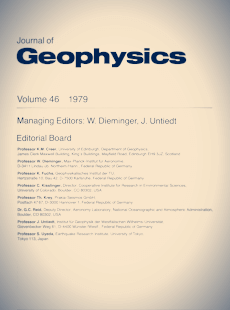Q of Mode 0S0
Article Sidebar
Published:
Apr 26, 1979
Keywords:
Q-0S0-Time lapse spectra,
Maximum Likelihood Method,
Ricean statistics
Volumes

Vols. 1-18 (1924-1944), ISSN 0044-2801
Main Article Content
L. Knopoff
Institute of Geophysics and Planetary Physics, UCLA Los Angeles, USA
P.A. Rydelek
Institute of Geophysics and Planetary Physics, UCLA Los Angeles, USA
W. Zurn
Black Forest Observatory, Karlsruhe University and Stuttgart University, Germany
T. Yogi
Department of Physics, Caltech, Pasadena USA
Abstract
Estimates of Q of mode oSo as measured after the Chilean (1960) and Alaskan (1964) earthquakes showed large scatter. The Indonesian quake of August 19, 1977, has provided a new opportunity to determine the attenuation factor for oSo. Time lapse spectra of a priori selected high quality data were analyzed using a maximum-likelihood method and Ricean statistics. Data from South Pole and Los Angeles gave Q values of 6324 (1 ±21 %) and 6859 (1 ± 17%) respectively. Taken together the result is 6687 (1 ± 13%).
 ARK: https://n2t.net/ark:/88439/y084078
ARK: https://n2t.net/ark:/88439/y084078
Permalink: https://geophysicsjournal.com/article/39
Article Details
How to Cite
Section
References
Buland, R., Berger, J., Gilbert, F. (1979) Observations from the IDA network of attenuation and splitting during a recent earthquake. Nature 277, 358-362
Knopoff, L. (1961) Statistical accuracy of the fault-plane problem, Publications of the Dominion Observatory. 24, 317-319
Middleton, D. (1968) An introduction to statistical communication theory. New Y ark: McGraw-Hill Book Co.
Nakanishi, K.K., Knopoff, L., Slichter, L.B. (1976) Observation of Rayleigh Wave dispersion at very long periods. J. Geophys. Res. 81,4417-4421
Ness, N.F., Harrison, J.C., Slichter, L.B. (1961) Observations of the free oscillations of the earth. J. Geophys. Res. 66, 621-629
Rice, S.O. (1944) Mathematical analysis of random noise, I. Bell System Tech. J. 23, 283-332
Rice, S.O. (1945) Mathematical analysis of random noise, II. Bell Syst. Tech. J. 24, 46-156
Rice, S.O. (1948) Statistical properties of a sine wave plus random noise, Bell Syst. Tech. J. 27, I 09-157
Sailor, R.V., Dziewonski, A.M. (1978) Measurements and interpretation of normal mode attenuation. Geophys. J. Roy. Astron. Soc. 53, 559-581
Slichter, L.B. (1967) Spherical Oscillations of the Earth, Geophys. J. R. Astron. Soc. 14, 171-177
Siichter, L.B., MacDonald, G.J., Caputo, M. Hager, C.L. (1966) Comparison of spectra for spheroidal modes excited by the Chilean and Alaskan quakes. Geophys. J. R. Astron. Soc. 11, 256
Smith, S.W. (1961) An investigation of the earth's free oscillations. California Institute of Technology, Pasadena, California, USA: PhD Thesis
Knopoff, L. (1961) Statistical accuracy of the fault-plane problem, Publications of the Dominion Observatory. 24, 317-319
Middleton, D. (1968) An introduction to statistical communication theory. New Y ark: McGraw-Hill Book Co.
Nakanishi, K.K., Knopoff, L., Slichter, L.B. (1976) Observation of Rayleigh Wave dispersion at very long periods. J. Geophys. Res. 81,4417-4421
Ness, N.F., Harrison, J.C., Slichter, L.B. (1961) Observations of the free oscillations of the earth. J. Geophys. Res. 66, 621-629
Rice, S.O. (1944) Mathematical analysis of random noise, I. Bell System Tech. J. 23, 283-332
Rice, S.O. (1945) Mathematical analysis of random noise, II. Bell Syst. Tech. J. 24, 46-156
Rice, S.O. (1948) Statistical properties of a sine wave plus random noise, Bell Syst. Tech. J. 27, I 09-157
Sailor, R.V., Dziewonski, A.M. (1978) Measurements and interpretation of normal mode attenuation. Geophys. J. Roy. Astron. Soc. 53, 559-581
Slichter, L.B. (1967) Spherical Oscillations of the Earth, Geophys. J. R. Astron. Soc. 14, 171-177
Siichter, L.B., MacDonald, G.J., Caputo, M. Hager, C.L. (1966) Comparison of spectra for spheroidal modes excited by the Chilean and Alaskan quakes. Geophys. J. R. Astron. Soc. 11, 256
Smith, S.W. (1961) An investigation of the earth's free oscillations. California Institute of Technology, Pasadena, California, USA: PhD Thesis











